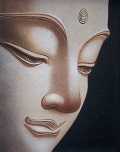Y not said: “So the beings are not the hadaya vatthu. They only have it. Is that what is meant? In that case, by what other names or descriptions are the beings themselves, as distinct from and beyond the hadaya vatthu, refered to in Buddhadhamma?”
How can a being be its hadaya vatthu? Hadaya vatthu is just a suddhashtaka, which is even smaller than an atom in modern science.
A human has an inert body that weighs tens of kg or hundreds of pounds.
Obviously that body is not the human, because at death it becomes inert and the gandhabba comes out. So, is gandhabba the “person”?
But a gandhabba essentially has a hadaya vatthu and five pasada rupa, where those pasada rupa are also suddhashtaka. So, in essence, that human can also be reduced a set of six rupa smaller than an atom.
That set of hadaya vatthu and five pasada rupa are NOT fixed or NOT unchanging. They decay and a new set arises due to kammic energy at a very fast rate.
This is why it cannot be said that there is a “self”.
However, one’s pancakkhandha (and panca upadanakkhandha and gati) remains accessible with that hadaya vatthu; of course there are NOT fixed and keep changing too. That is why it cannot be said that there is “no self”.
I am re-stating this basic picture because it is critical to understand. See, “What Reincarnates? – Concept of a Lifestream“.
